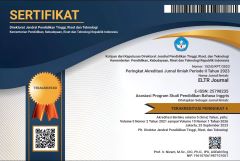WOMEN’S LANGUAGE FEATURES USED BY SARAH SECHAN IN HER TALK SHOW
Abstrak terlihat: 959 / PDF terunduh: 651DOI:
https://doi.org/10.37147/eltr.v3i2.76Keywords:
Sarah Sechan, women’s language features, talk showAbstract
Every human being needs to communicate to each other. Men and women are different in terms of using a language or languages in their daily conversation. Women’s language proved that women tend to use language differently than men, it is shown in features they use. Sarah Sechan is one of well-known, multitalented, communicative, and creative presenters in Indonesia. It is proved by the words choices in her speech. So, the researcher chose her to be one of the instruments in gathering the data. Therefore, the researcher build a research question as follows : What are the women’s language features used by Sarah Sechan? The researcher used qualitative data methods by employing content analysis to answer the research question. There were 2 research instruments used in this research. They were the researcher as the human research and observation sheet. In this research, the researcher found that nine features were used, there were:. 48 empty adjectives (23.415%), 44 intensifiers (21.463%), 35 features of lexical hedges (17.073%). 18 features of tag question (8.780%), 16 hyper-correct grammar (7.804 %), 15 features of rising intonation (7.317%), 11 Super-polite (5.366%), 9avoidance of strong swear words (4.390%), and 9 features of emphatic stress (4.390%).
Downloads
References
Archibald, J. Aronoff. O’Grady, W., & Ress-Miller, J. (2010). Contemporary linguistic: An introduction (6th ed.) New York: St.Martin’s Press.
Ary, D., Jacobs, L. C., & Razavieh, A. (2002). Introduction to research in education (6th ed.). Belmont: Wadsworth Thomson Learning.
Bruun, H. (1999). Talkshowet. Valby: Borgens Forlag.
Holmes, J. (1992). An introduction to sociolinguistics. New York: Addison-Wesley Longman Ltd.
Lakoff, R. (1975). Language and woman’s place. New York: Harper Colophon.
Landman, T. (2000). Issues and methods in comparative politics: An introduction. London: Routledge.
Neuman, W. L. (2000). Social research methods: Qualitative and quantitative approaches (4th ed.). Needham: Allyn & Bacon Ltd.
Netmediatama. (2013). Sarah Sechan-Shane Filan-Penyanyi. Retrieved on February 26, 2018, from https://www.youtube.com/watch?v=D55UWZL36To.
Netmediatama. (2014). Sarah Sechan-Jorge Lorenzo. Retrieved on February 26, 2018, from https://www.youtube.com/watch?v=rbFdOk73ROY&t=25s.
Netmediatama. (2014). Sarah Sechan-Angie Miller. Retrieved on February 26, 2018, from https://www.youtube.com/watch?v=sjo5M5TGs-M&t=34s.
Netmediatama. (2016). Sarah Sechan-Jessie J. Retrieved on February 26, 2018, from https://www.youtube.com/watch?v=8abWn9Veis0&t=57s.
Netmediatama. (2017). Sarah Sechan-Robin Thicke. Retrieved on February 26, 2018, from https://www.youtube.com/watch?v=bh0EQEgA8Xw.
Poole, S. C. (1999). An introduction to linguistics. New York: Palgrave Macmillan
Pebrianti, A. A. (2013). Women’s language features used by Indonesian female bloggers. An Indonesian Journal Passage2013, 2(1), 109-118. Retrieved on January 24, 2018, from ejournal.upi.edu/index.php/psg/article/download/543/418
Pan, Q. (2011). On the features of female language in English. A Journal of Theory and Practice in Language Studies, 1(8), 1015-1018.
Spolsky, B. (1998). Sociolinguistics. Oxford: Oxford University Press.
White, A. (2003). Womens’ usage of specific linguistic functions in the context of casual conversation: Analysis and discussion. England: University of Birmingham. Retrieved on February 5, 2018, from www.birmingham.ac.uk/artslaw/sociolinguistics/White5.p.
Widdowson, H. G. (1996). Linguistics. New York: Oxford University Press.
Downloads
Published
How to Cite
Issue
Section
License
Copyright (c) 2020 Maria Catharina Gustia Apridaningrum, Patricia Angelina

This work is licensed under a Creative Commons Attribution-ShareAlike 4.0 International License.













